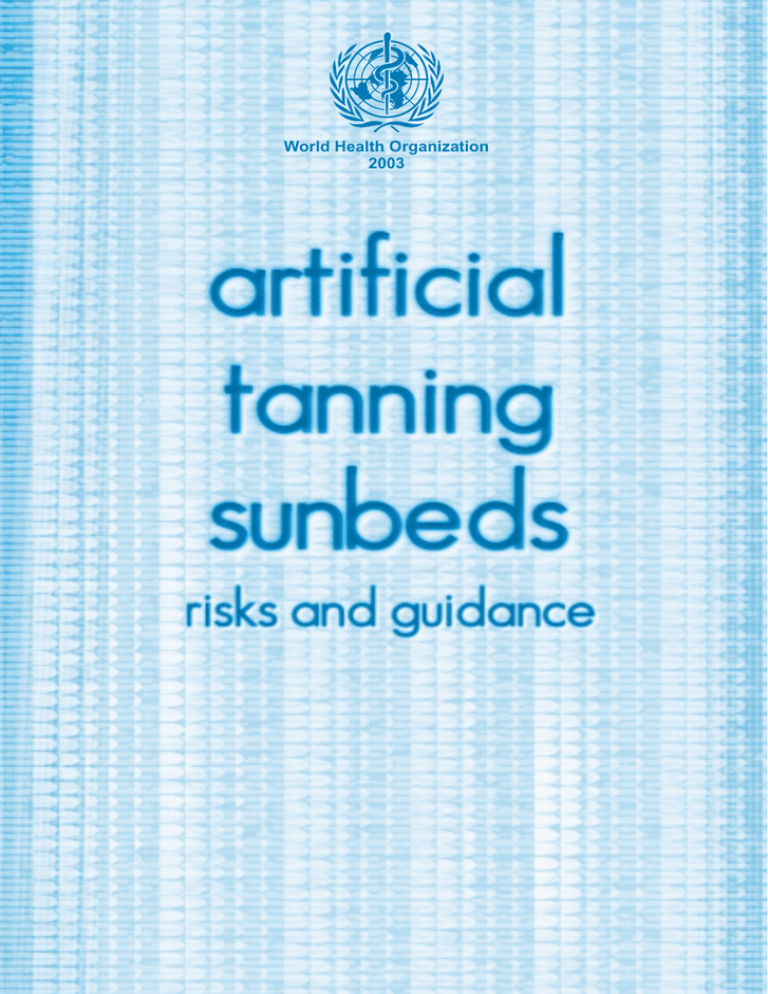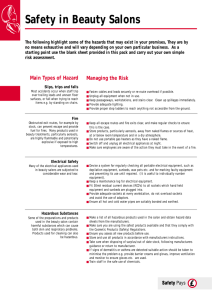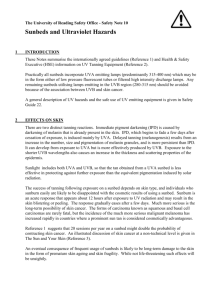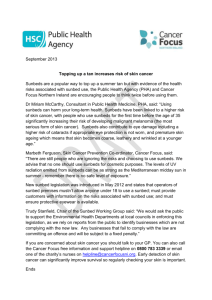World Health Organization 2003
advertisement

World Health Organization 2003 World Health Organization 2003 artificial tanning sunbeds risks and guidance WHO Library Cataloguing-in-Publication Data World Health Organization.. WHO guidance brochure : artificial tanning sunbeds / prepared by Craig Sinclair. 1.Ultraviolet rays - adverse effects 2.Beds - standards 3.Skin pigmentation 4.Skin neoplasms - etiology 5. Skin aging 6.Policy making 7.Guidelines I.Sinclair, Craig. II.Title. ISBN 92 4 159080 7 (NLM classification: WD 605) © World Health Organization 2003 All rights reserved. Publications of the World Health Organization can be obtained from Marketing and Dissemination, World Health Organization, 20 Avenue Appia, 1211 Geneva 27, Switzerland (tel: +41 22 791 2476; fax: +41 22 791 4857; email: bookorders@who.int). Requests for permission to reproduce or translate WHO publications – whether for sale or for noncommercial distribution – should be addressed to Publications, at the above address (fax: +41 22 791 4806; email: permissions@who.int). The designations employed and the presentation of the material in this publication do not imply the expression of any opinion whatsoever on the part of the World Health Organization concerning the legal status of any country, territory, city or area or of its authorities, or concerning the delimitation of its frontiers or boundaries. Dotted lines on maps represent approximate border lines for which there may not yet be full agreement. The mention of specific companies or of certain manufacturers’ products does not imply that they are endorsed or recommended by the World Health Organization in preference to others of a similar nature that are not mentioned. Errors and omissions excepted, the names of proprietary products are distinguished by initial capital letters. The World Health Organization does not warrant that the information contained in this publication is complete and correct and shall not be liable for any damages incurred as a result of its use. Printed in iv Contents Preface 2 Artificial Ultraviolet Radiation Devices 3 The Association of Sunbed Use with Skin Cancer, Skin Ageing and Eye Damage 4 Skin Cancers 4 Skin Ageing 4 Eye Damage 4 Why Sunbeds are an Important Health Issue 5 Recommendations for Government Health Ministries 7 Recommendations for the Management of Sunbed Operations 8 Annex 11 Sample Client Consent Form: Important Information on Using a Sunbed 11 Glossary 12 References 13 1 Preface Ultraviolet (UV) radiation comes from the sun and other sources. The UV region covers the wavelength range 100–400 nm and is divided into three bands: UVA, UVB, and UVC. All three bands are classified as a probable human carcinogen. Sunbeds emit UVA and UVB radiation. In general, sunbeds predominantly emit UVA radiation, which is thought to be the least damaging of the UV radiation spectrum. However in recent years, sunbeds have been manufactured that produce higher levels of UVB to mimic the solar spectrum and speed the tanning process. Overexposure to UV radiation from the sun and artificial sources is of considerable public health concern. UV radiation plays an important role in the development of skin cancer, cataracts, and other eye conditions, and suppresses the immune system. Cumulative UV radiation also results in premature skin ageing. Between two and three million non-melanoma skin cancers and approximately 132 000 malignant melanomas occur globally each year. One in every three cancers diagnosed worldwide is a skin cancer. In addition, estimates from the World Health Organization (WHO) show that sun exposure may have been a key contributor to the development of cataracts in up to 20% of people who have cataracts. While WHO does not recommend the use of UV tanning devices for cosmetic purposes, it is recognized that sunbeds continue to be available to the public. For this reason there is a need for guidance to reduce the risks associated with their use. This practical guide, prepared by Craig Sinclair, WHO, is intended for government health authorities, to assist them in the development of public health policy in relation to sunbeds. A CKNOWLEDGMENT WHO thanks the following people who reviewed this document: Philippe Autier, Luxembourg Health Institute, Luxembourg Pièrre Cesarini, Sécurité Solaire, France Howard Cyr, Food and Drug Administration, United States Colin Driscoll, National Radiological Protection Board, United Kingdom Peter Gies, Australian Radiation Protection and Nuclear Safety Agency, Australia Rüdiger Greinert, Dermatologisches Zentrum Buxtehude, Germany Drusilla Hufford, US Environmental Protection Agency, United States Amanda Marlin, World Health Organization, Geneva Jill Meara, National Radiological Protection Board, United Kingdom Sharon Miller, US Food and Drug Administration, United States Andy Pearson, National Radiological Protection Board, United Kingdom Pascale Reinhardt, Health Canada, Canada Mike Repacholi, World Health Organization, Geneva Colin Roy, Australian Radiation Protection and Nuclear Safety Agency, Australia Ulf Wester, Swedish Radiation Protection Authority, Sweden 2 Artificial Ultraviolet Radiation Devices The desire to acquire a tan for fashion or cosmetic purposes has led to the development of a large artificial tanning industry in mostly western countries where many residents have pale skins. Exposure to ultraviolet (UV) radiation causes darkening of the skin’s pigment melanin to produce a tan, except for people whose skin does not tan but only burns (skin phototype I: see table below). In principle, a person’s reaction to UV radiation (tanning or sunburning) is similar whether the exposure is to natural (solar) or artificial (sunbed) UV radiation 1. In 1994 the World Health Organization (WHO) issued a major scientific review 2 that stated that there are adverse health effects associated with sunbed use. The findings of this report have been supported since by a number of key authorities including the International Commission on NonIonizing Radiation Protection 1, the National Toxicology Program of the Department of Health and Human Services 3, the National Radiological Protection Board (United Kingdom) 4, the National Health and Medical Research Council (Australia) 5 and EUROSKIN 6. In Hamburg 2000, a WHO workshop on sunbeds was held at the inaugural EUROSKIN Conference. The outcomes from this workshop are documented in the recommendations contained in this report. Table 1 Classification of skin types based on their susceptibility to sunburn in sunlight 7 SKIN PHOTO TYPE SUNBURN SUSCEPTIBILITY TANNING ABILITY CLASSES OF INDIVIDUALS I Always sunburn No tan Melano-compromised II High Light tan III Moderate Medium tan IV Low Dark tan V Very low Natural brown skin VI Extremely low Natural black skin Melano-competent Melano-protected Artificial UV radiation devices are used to treat certain medical conditions such as vitamin D deficiency and psoriasis. However, such treatment should only be carried out under medical supervision. For the majority of the population, incidental exposure to the sun, combined with dietary intake of vitamin D, provides adequate vitamin D throughout the year. 3 The Association of Sunbed Use with Skin Cancer, Skin Ageing and Eye Damage Adverse health affects associated with sun exposure, such as skin cancer and premature skin ageing, have been well documented in international and national reports 4,8,2 and peer reviewed medical journals. Skin Cancers There is increasing evidence from both experimental and epidemiological data that cumulative exposure to UV radiation increases the risk of skin cancers. Therefore the added exposure from UV tanning appliances is likely to add to the well known detrimental consequences of natural solar exposure 9. There is no evidence to suggest that any type of sunbed is less harmful than natural sun exposure. Precancerous actinic keratoses and Bowen’s disease have also been reported in sunlight-protected but sunbed-exposed skin in fair skinned users after just two to three years of regular sunbed use 10. Skin Ageing Structural damage to human skin from exposure to UV radiation causes, in the short term, burning, fragility and scarring, and in the longer term, photoageing 11,12, 2,13. Photoageing includes wrinkling and loss of skin elasticity. It is generally irreversible without cosmetic surgery. Eye Damage Acute effects of UV radiation on the eye include photokeratitis, inflammation of the cornea and the iris, and photoconjunctivitis (an inflammation of the conjunctiva, the membrane that lines the inside of the eyelids and white of the eye). Long-term eye effects of UV radiation exposure may include the development of pterygium (white or creamy opaque growth attached to the cornea), and squamous cell cancer of the conjunctiva. 4 Why Sunbeds are an Important Health Issue S IZE OF THE SUNBED INDUSTRY AND THE NUMBER OF PEOPLE USING THEM Sunbeds are an important public health issue because of the size of the artificial tanning industry in terms of the number of commercial sunbeds and the number of people using them. In the United States alone, artificial tanning is a $1 billion-a-year industry and continues to grow 14. In Northern Europe, approximately 10% of the population use sunbeds on a regular basis for tanning purposes 15. A study in Sweden schematically estimated that the population’s UV radiation dose due to artificial tanning might be of the same order of magnitude as the potential increase in natural UV radiation dose resulting from a 10% ozone depletion 16. Even in Australia, a country that has high UV radiation levels, 9% of people aged 14–29 have reported using a sunbed in the past 12 months 17. These figures indicate that considerable numbers of people are increasing their risk of skin cancer and skin ageing – which won’t be statistically recognized for many years to come. Consequences of regular sunbed use could include pain and suffering, early death, and disfigurement, as well as substantial costs to national health systems for screening, treating, and monitoring skin cancer patients. L IMITED CONTROLS GOVERNING SUNBED USE Where government controls exist in relation to commercial sunbed operations, they are usually limited in their application and scope. For example, in the United States, the primary national regulations relating to sunbeds are governed by the Food and Drug Administration 18, which requires sunbed manufacturers to have warning labels about skin types and advise users to wear goggles to protect the eyes. With the exception of some limited IEC Standards, in Europe there is no standardization of regulations relating to sunbed use 9. Belgium and Sweden have implemented government controls but France appears to have the most comprehensive legislation. In France, the regulations require all UV radiation emitting appliances to be declared to the health authority, require people under the age of 18 to be banned from using a sunbed, require trained personnel to supervise all commercial establishments, and forbid any claim of health benefit 19. Unlike some commercial sectors, the sunbed industry has not shown significant capacity to self-regulate effectively. 5 H IGH INTENSITY OF UV RADIATION OUTPUT Some machines have the capacity to emit levels of UV radiation up to five times 20 stronger than the midday Australian summer sun. Such intensity in a largely unregulated industry where training of staff is not mandatory increases the health risks considerably. The risk is greater in unsupervised commercial sunbed operations and when sunbeds are used in the home, where the duration of UV radiation exposure is up to the discretion of the individual. E FFECT OF CERTAIN DRUGS AND COSMETICS Some drugs, for example, anti-depressants, antibiotics, psoralens, antifungals, and antidiabetics, as well as some cosmetics, can make the skin more photosensitive and therefore decrease the time it takes for the skin to burn. Where there is a lack of trained staff or other methods of risk assessment, the potential for harm to the uninformed consumer is considerably greater. L IMITATION OF CERTAIN SKIN TYPES People with skin phototype I will not tan after exposure to a sunbed. They will only burn. Unfortunately, without adequate sunbed operator training or supervised operations, the ability of the consumer to recognize their skin as not suitable for sunbed use is based on either self-diagnoses or, at worst, bad experience. L IMITED PROTECTION AGAINST SUNBURN A sunbed-acquired tan offers only limited protection against sunburn from solar UV radiation. A tan developed in a sunbed has in most cases only the same protective effect as a SPF 2 or 3 sunscreen 21. I NCREASE IN THE NUMBER OF SELF - SERVICE ( UNSUPERVISED ) MACHINES A major health concern in recent times has been the increase in the number of unsupervised commercial sunbeds. When such operations are combined with competitive pricing strategies, such as unlimited sessions within a specific timeframe, there is a greater likelihood for skin damage. D ANGERS ASSOCIATED WITH CHILDHOOD UV EXPOSURE Childhood exposure to UV radiation is known to make an important contribution to the risk of developing melanoma later in life 22. For this reason, particular attention is required to ensure children do not use sunbeds. T HE SIZE OF THE SKIN AREA EXPOSED Modern “clam-type” tanning beds and canopies generally expose more of one’s skin area to UV radiation than it would be in most outdoor situations, therefore increasing the health risk. 6 Recommendations for Government Health Ministries Governments should consider comprehensive legislation governing the operation of sunbeds. Any legislation should be legally binding and be capable of local enforcement. In countries where comprehensive regulations have been implemented, the emphasis has been on providing better information for consumers, restricting access to those under the age of 18 and reducing the numbers of automated tanning parlours working without the surveillance of an operator 9. If a system of licensing commercial sunbed operators is implemented, it will be important to ensure that licenses are not granted in a way that suggests that licensed sunbeds are safe either in absolute terms or in comparison to unlicensed operators. If the political environment does not suit legislation, then governments can consider a comprehensive set of standards in conjunction with the artificial tanning industry that reflects the recommendations contained in this guide. In this case, self-regulation by the artificial tanning industry should be supported. 7 Recommendations for the Management of Sunbed Operations Based on International Commission on Non-Ionizing Radiation Protection 1 recommendations, people should not use artificial tanning devices if they: • Have melano-compromised skin (skin phototypes I and II), i.e. their skin always sunburns with no ability to tan or has a high susceptibility to sunburn with only an ability to develop a light tan. (See Introduction for table of skin classification definitions.) • Are less than 18 years of age. • Have large numbers of nevi (moles). • Tend to freckle. • Have a history of frequent childhood sunburn. • Have pre-malignant or malignant skin lesions. • Have sun damaged skin. • Are wearing cosmetics. This may enhance their sensitivity to UV exposure. • Are taking medications. In this case they should seek advice from their physician to determine if the medication will make them UV radiationsensitive. If however, artificial tanning devices are used, then the following points are recommended as a guide for the development of policy in this area. T ANNING DEVICES Sunbed tanning devices should comply with the requirements of the International Electrotechnical Commission’s (IEC) Standard 23 or national standards where they exist. Manufacturers should supply exposure schedules based on the tanning device lamp characteristics. E YEWEAR UV radiation protective eyewear must be worn during tanning exposures. A GE LIMIT No one under the age of 18 should use a sunbed. 8 C LIENT INFORMATION Warning notices In a commercial establishment, one or more notices, each with minimum dimensions of 21 cm x 30 cm (i.e. approximately A4 paper size) and presenting the following information in legible print, should be placed so it is within the immediate view of every client entering the establishment and in each sunbed cubicle: • Exposure to ultraviolet radiation such as from a sunbed contributes to the skin ageing process and may cause skin cancer. • People with skin that does not tan in natural sunlight should not use a sunbed. • Intentional exposure to sunlight or sunbed should be avoided for 48 hours after sunbed exposure. • UV radiation protective goggles must be worn at all times while undergoing sunbed exposure. • No person under the age of 18 should use a sunbed. Client consent form Before beginning a tanning course of one or more exposure sessions, the sunbed operator should ensure that a consent form is handed to the client (see sample in Annex). This will ensure that the consumer has every opportunity to understand the risks associated with sunbed use. The sunbed operator should further ensure that: • the client signs and dates the form • the client returns the signed and dated form before the first tanning session in the establishment • the original signed and dated form is filed in the records of the establishment for a period of not less than two years • a copy of the signed and dated form is handed to the client. The Annex includes a sample client consent form. M AXIMUM EXPOSURE TIMES AND IRRADIANCE Maximum exposure times should ensure that no person suffers erythema (skin reddening) as a result of UV radiation exposure in a sunbed. Particular caution must be exercised with first time users to gauge the user’s skin response. If adverse reactions occur, further use should be discouraged. No UVC (less than 280 nm) should be emitted from a sunbed. 9 M AXIMUM REPEAT EXPOSURE Further artificial sunbed exposure should not be administered before 48 hours after the previous exposure. An occasional break from the regularity of exposure is advisable. P ROMOTION Claims of health benefits should not be made in the promotion of sunbed use. S KIN TYPE EXCLUSION People with skin phototypes I and II should not be allowed to use a sunbed. (See Introduction for definitions of classification.) S UPERVISION Whether it is a single purpose retail sunbed facility or whether a sunbed is part of a hotel, recreation centre, beauty parlour and the like, a trained supervisor should be available at all times the sunbed is in operation. S UNBED OPERATOR TRAINING Any person who is supervising the operation of a commercial sunbed should be properly trained in the following: • proper determination of skin types and exposure times • proper screening for potentially exposure-limiting conditions • emergency procedures in case of overexposure to UV radiation • types and wavelength of UV radiation • proper procedures for sanitising protective eyewear and tanning equipment. U NSTAFFED , COIN - OPERATED ESTABLISHMENTS Unsupervised, self-service sunbeds should be banned or at least discouraged from operating. T HERAPEUTIC USE OF SUNBEDS Therapeutic use of sunbeds should only be conducted in a medical unit under medical supervision. T AN ACCELERATORS Products designed to enhance or accelerate tanning should not be used. 10 Annex Sample Client Consent Form: Important Information on Using a Sunbed Please read carefully the following information. Exposure to ultraviolet (UV) radiation contributes to the skin ageing process and may cause skin cancer. People with fair skin who are unable to tan shall not use a sunbed. Intentional sunbed exposure should be avoided for 48 hours before and after sunlight or sunbed exposure. Protective goggles must be worn at all times while undergoing sunbed exposure. You must not read while the sunbed is in operation. There is additional risk, and sunbed exposure is not recommended if: • you have ever been treated for solar keratoses or skin cancer; or • you have ever suffered from an abnormal reaction, or allergy, to light. There may be further risk if you are pregnant, taking certain medications, or applying medications or certain cosmetics to the skin. If you have any doubt, consult your doctor before undergoing any UV radiation exposure. I am over the age of 18, and I, (print full name) …………………….…………, have carefully read and fully understood the above information and choose to undergo UV radiation exposure in this establishment. Signed: Date: Name of establishment: 11 Glossary erythema Reddening of the skin, more commonly called sunburn. intentional exposure Trying to achieve a tan by lying in the sun, or in a sunbed/booth with minimal clothing, to maximize skin exposure. solaria Commercial establishments that contain one or more sunbed units. sunbed An electrically powered appliance or installation intended to produce tanning of the human skin by utilizing UV radiation. sunbed operator A person or corporation having ultimate control and management of one or more sunbeds in a commercial establishment. ultraviolet (UV) radiation Part of the solar emissions that include light, heat, and UV radiation. UV region covers the wavelength range 100–400 nm and is divided into three bands: UVA, UVB, and UVC. All three bands are classified as a probable human carcinogen. UVA radiation Long-wavelength UVA covers the range 315–400 nm. Not significantly filtered by the atmosphere. Approximately 90% of UV radiation reaching the Earth’s surface. UVB radiation Medium-wavelength UVB covers the range 280–315 nm. Approximately 10% of UV radiation reaching the Earth’s surface. UVC radiation Short-wavelength UVC covers the range 100–280 nm. All solar UVC radiation is absorbed by the ozone layer. 12 References 1. International Commission on Non-Ionizing Radiation Protection (ICNIRP). Health issues of ultraviolet tanning appliances used for cosmetic purposes. Health Phys 2003;84(1):119-27. 2. International Programme on Chemical Safety (United Nations Environment Programme, International Labour Organisation, World Health Organization). Environmental health criteria 160: ultraviolet radiation. Geneva: World Health Organization, 1994. 3. National Toxicology Program, United States Department of Health and Human Services (USDHHS). Tenth report on carcinogens. USDHHS, 2002. 4. National Radiological Protection Board. Health effects from ultraviolet radiation: report of an advisory group on non-ionising radiation. Vol 13, no 1. Oxfordshire: National Radiological Protection Board, 2002. 5. National Health and Medical Research Council. Suntanning parlours, solaria, home tanning equipment. Position statement, 2002. 6. Greinert R, McKinlay A, Breitbart E. The European Society of Skin Cancer Prevention EUROSKIN: towards the promotion and harmonization of skin cancer prevention in Europe. Recommendations. Eur J Cancer Prev 2001;10(2):157-62. 7. Adapted from Fitzpatrick TB, Bolognia JL. Human melanin pigmentation. In: Zeise L, Chedekel MR, Fitzpatrick TB, eds. Melanin: its role in human photoprotection. Overland Park, KS: Valdenmar Publishing Co, 1995. 8. International Agency for Research on Cancer (IARC). Solar and ultraviolet radiation. Monographs on the evaluation of the carcinogenic risk to humans. Lyon: IARC, 1992;55. 9. Autier P. Issues on solaria. In: Hill D, Elwood M, English D, eds. Prevention of skin cancer. United States: Klewer, 2002 (in press). 10. Hawk J. Sunbeds. Radiat Prot Dosimetry 2000; 9(1-3):143-5. Cites Speight EL, Dahl M, Farr P. Actinic keratoses induced by sunbed. BMJ 1994;308:415. 11. Shuttleworth, D. Sunbeds and the pursuit of the year round tan. BMJ 1993;307:1508-9. 12. Hawk J. Sunbeds. Radiat Prot Dosimetry 2000;9(1-3):143-5. 13. Lavker RM, Veres DA, Irwin CJ, Kaidbey KH. Cumulative effects from repeated exposures to suberythemal doses of UVB and UVA in human skin. J Am Acad Dermatol 1995;32:53. 14. Spencer J, Amonette R. Indoor tanning: risks, benefits, and future trends. J Am Acad Dermatol 1995;33:288-98. 15. The truth about tanning. Which? London Consumers Association, 1987. 16. Wester U, Boldeman C, Jansson B, Ullen H. Population UV-dose and skin area – do sunbeds rival the sun? Health Phys 1999;77(4):436-40. 13 17. Dobbinson S, Borland R. Reaction to the 1997/98 SunSmart Campaign: results from a representative household survey of Victorians. In: SunSmart Evaluation Studies No 6. Melbourne: Anti-Cancer Council of Victoria, 1999;47-68. 18. United States Food and Drug Administration. Sunlamps products; performance standards: final rule (21 CFR 1040) Federal Register 50: 36548-36552. 19. Cesarini JP. The French regulations for ultraviolet radiation sunbeds. Radiat Prot Dosimetry 2000;91(1-3):205-7. 20. Standards Australia/Standards New Zealand Committee. Australian/New Zealand standard for the installation, maintenance, and operation of solaria for cosmetic purposes (revision of AS 2635-1983). AS/NZA 2635:2002. Sydney: Standards Australia, 2002. 21. Hawk J. Sunbeds. Radiat Prot Dosimetry 2000; 9(1-3):143-145. Cites Devgun M, Johnson B, Patterson C. Tanning, protection against sunburn and vitamin D formation with a UVA sunbed. Br J Dermatol 1982;107:275-84. 22. Armstrong BK, Kricker A. Epidemiology of sun exposure and skin cancer. Cancer Surveys 1996;26. 23. International Electrotechnical Commission. Safety of household and similar electrical appliances. Part 2: Particular requirements for appliances for skin exposure to ultraviolet and infrared radiation. Geneva: IEC, 1995;335:2-27. 14





